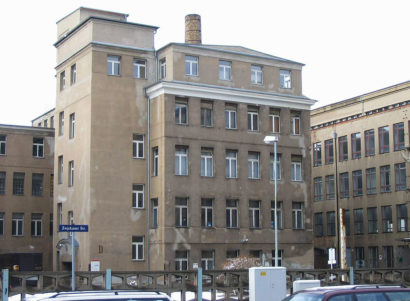Dresden (Universelle) Subcamp
October 9, 1944 – mid-April 1945
In October 1944, three subcamps for female prisoners were established in Dresden: two for Zeiss Ikon AG (in the Goehle-Werk and Dresden-Reick), one in the Universelle machinery factory.
![]()
Former Universelle factory grounds on Florastraße in Dresden, 2019 (Flossenbürg Concentration Camp Memorial / Photo: Rainer Viertlböck).
![]()
Zwickauer Straße in Dresden, 2006 (Photo: Flossenbürg Concentration Camp Memorial). Prisoners also had to work in this factory for Universelle. After the war, the state enterprise Tabakuni built tobacco machines here. Today, the factory halls are vacant.
-
Prisoners
All prisoners were deported from the Ravensbrück concentration camp. The first transport with 500 women was in October 1944, another 200 in February 1945. German political prisoners, “asocials” and “gypsies,” were in the majority, followed by Latvian, Russian, Serbian, and Czech women. 685 prisoners were recorded as “released” in the company’s records for March 26, 1945.
-
Forced labor and quarters
Assembling of regulators for airplane engines in the works of the Universelle machinery factory (Florastraße 14). The women were quartered in the upper two floors of the building, while others were quartered in a barrack on the factory grounds and worked in a factory hall in Zwickauer Straße.
-
Guards
SS guards, female overseers. Head overseer Charlotte Hanakam and, from October 1944, Ida Guhl acted as detail leaders. Hanakam brutally mistreated prisoners.
-
Death toll
Many women were reported to have died directly from the bombing of the factory on February 14, 1945; however, no fatalities were recorded in the Flossenbürg registers.
-
Disbanding of the camp / end of the war
Many women took advantage of the chaos after the bombing to escape. Fewer than 100 prisoners were marched to Mockethal-Zatzschke, where some women are said to have been killed. The remaining women were forced to march on to Pirna; the march came under attack by planes and dispersed. The surviving women were liberated by the Allies.
-
Commemoration
Art project "Scars of the War": Memorial Depots Location 17, a stainless steel case embedded in the floor (»Gravuren des Krieges«: Mahndepot Ort 17, eine in den Boden eingelassene Edelstahlhülse), marked 2001. A newspaper insert documented the place and its significance.

